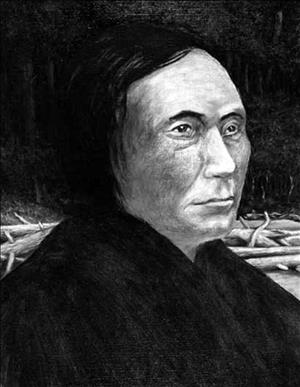On February 19, 1858, Nisqually Chief Leschi (1808-1858) is hanged on a gallows in Steilacoom for the "murder" of the American soldier Colonel A. Benton Moses. Chief Leschi's attorneys argued firstly that Leschi had not actually been the one to kill Colonel Moses, and secondly that Colonel Moses was killed during warfare (in which there were casualties on both sides), requiring that his accused killer should not be tried in a civilian court. On March 4, 2004, the Washington State Senate formally recognized "the injustice which occurred in 1858 with the trial and execution of Chief Leschi" and honored Chief Leschi as "a courageous leader" and "a great and noble man" (Washington State Senate Resolution 8727).
Medicine Creek Treaty
Leschi had been friendly to American settlement, but he signed the Medicine Creek Treaty of 1854 under protest (some claim that the X beside his name was not put there by him, but others dispute this claim), objecting to the two-square-mile reservation with no access to the Nisqually River which the treaty assigned to this tribe that had lived and fished on the river for many generations.
Leschi led probably 300 troops against the United States and settlers in the skirmishes of the Treaty Wars in 1855 and 1856. Leschi was captured by his nephew Sluggia for a reward. Sluggia was later killed by Leschi lieutenant Wa He Lut.
Leschi's Statement and Hanging
His first trial resulted in a hung jury. At his appeal trial (at the Supreme Court of Washington Territory), at which he was found guilty, Leschi said through an interpreter:
"I do not know anything about your laws. I have supposed that the killing of armed men in wartime was not murder; if it was, the soldiers who killed Indians are guilty of murder too ... I went to war because I believed that the Indian had been wronged by the white men, and I did everything in my power to beat the Boston soldiers, but, for lack of numbers, supplies and ammunition, I have failed.
"I deny that I had any part in the killing ... As God sees me, this is the truth" (Wilkinson).
About 300 people gathered around an outdoor gallows to witness the execution. There were a few Nisqually at the edge of the crowd and Indian drums could be heard in the distance. His hangman, Charles Grainger, recalled:
"He did not seem to be the least bit excited at all – nothing of the kind, and that is more than I could say for myself. In fact Leschi seemed to be the coolest of any on the scaffold. He was in good flesh and had a firm step and mounted the scaffold without assistance, and as well as I did myself. I felt then I was hanging an innocent man, and I believe it yet."
Reburial
On July 4, 1895, Leschi was reburied on tribal land in a ceremony attended by about a thousand people. Ezra Meeker, who in 1858 had voted to acquit Leschi, chartered a train to escort white Tacomans to the ceremony. To him, according to Alexandra Harmon in Indians in the Making, Leschi was "a patriotic martyr to [Governor Isaac] Steven's political ambition and ill-conceived policies." (However Meeker's role in the Leschi case is quite ambiguous. It is likely that on January 26, 1858, Meeker was at the forefront of a meeting of Pierce County citizens protesting that "the notorious Indian Leschi's" sentence had not been carried out [Pioneer and Democrat, February 12, 1858].)
The Northern Pacific Railroad ran an excursion train to Maxfield, which the Nisqually area was called in the late 1800s and which was about two miles from the burial site. Tribal members with wagons met visitors to carry them to the ceremony.
Washington Honors Leschi
On March 4, 2004, the Washington State Senate resolved as follows:
"...That the Senate recognize the injustice which occurred in 1858 with the trial and execution of Chief Leschi and reaffirm the commitment to a legal system under which a fair trial is the right of everyone regardless of race or creed; and
"BE IT FURTHER RESOLVED, That the Senate recognize Chief Leschi as a courageous leader whose sacrifice for his people is worthy of honor and respect and that the residents of the State of Washington solemnly remember Chief Leschi as a great and noble man; and
"BE IT FURTHER RESOLVED, That the Senate join with those who hope that the Nisqually Tribe is successful in its efforts to right a gross injustice through a vacation of his conviction by the Washington Supreme Court ..." (Senate Resolution 8727).
On December 10, 2004, a special historical court, consisting of seven present and former justices of the State Supreme Court, exonerated Chief Leschi of the charge of murder, because he and Moses were both legal combatants in a war. State Supreme Court justice Gerry Alexander announced the decision, stating, "Chief Leschi should not, as a matter of law, have been tried for the crime of murder." The decision has no legal significance but represents a victory in the efforts of the Nisqually tribe to exonerate the name of their legendary chief.

